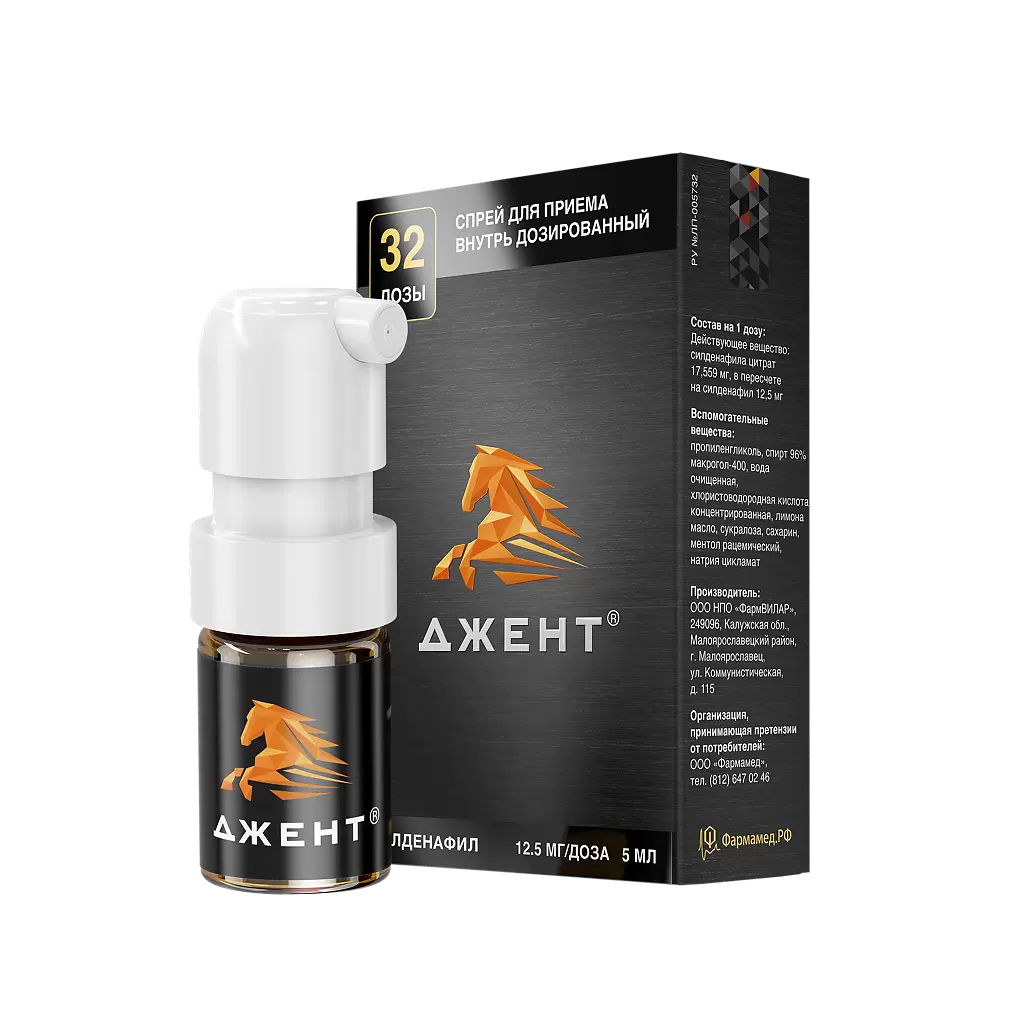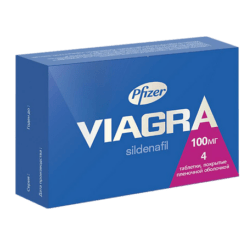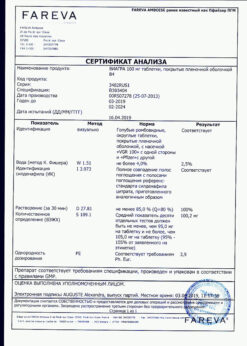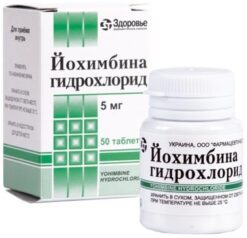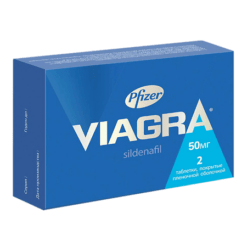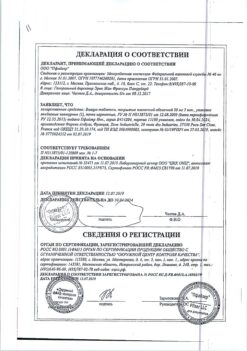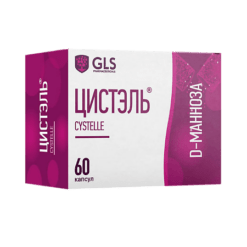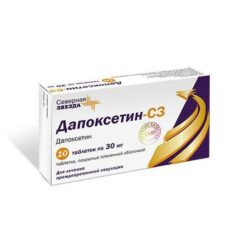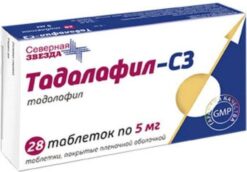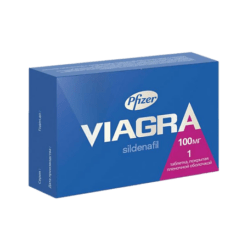No products in the cart.
Gent, 12.5mg/dose 5 ml
€41.38 €34.49
Description
Pharmacotherapeutic group: Erectile dysfunction treatment – FDE5 inhibitor.
ATX code: G04BE03
Pharmacological properties
Pharmacodynamics
Sildenafil is a selective inhibitor of cycloguanosine monophosphate (cGMP)-specific phosphodiesterase type 5 (FDE5).
The mechanism of action
The realization of the physiological mechanism of erection is associated with the release of nitric oxide (NO) in the cavernous body during sexual stimulation. This in turn leads to an increase in cGMP levels, a subsequent relaxation of the smooth muscle tissue of the corpora cavernosa and an increase in blood flow.
Sildenafil has no direct relaxant effect on the isolated human cavernous body, but it enhances the effect of nitric oxide (NO) by inhibiting FDE5, which is responsible for the breakdown of cGMP.
Sildenafil is selective against FDE5 in vitro, its activity against FDE5 is superior to other known phosphodiesterase isoenzymes: FDE6, 10 times; FDE1, more than 80 times; FDE2, FDE4, FDE7-FDE11, more than 700 times. Sildenafil is 4,000 times more selective against FDE5 compared to FDEZ, which is of great importance because FDEZ is one of the key enzymes regulating myocardial contractility.
Sexual stimulation is necessary condition for effectiveness of sildenafil.
Pharmacokinetics
The pharmacokinetics of sildenafil in the recommended dose range is linear.
Intake
After oral administration, sildenafil is rapidly absorbed. Absolute bioavailability averages about 40% (25% to 63%). In vitro sildenafil at a concentration of about 1.7 ng/ml (3.5 nM) inhibits human FDE5 activity by 50%. After a single sildenafil dose of 100 mg, the average maximum plasma concentration (Cmax) of free sildenafil in men is about 18 ng/ml (38 nM). Cmax when sildenafil is taken orally on an empty stomach is reached on average within 60 min (30 to 120 min). When taken in combination with fatty food the absorption rate decreases: Cmax is decreased by 29 % on average, and time to maximum concentration (Tmax) is increased by 60 min, but absorption degree does not change significantly (area under the pharmacokinetic curve of concentration-time (AUC) is decreased by 11 %).
Distribution
The volume of distribution of sildenafil in the equilibrium state averages 105 liters. The binding of sildenafil and its main circulating N-demethyl metabolite to plasma proteins is about 96% and is independent of the total drug concentration. Less than 0.0002% of the sildenafil dose (188 ng on average) is detected in semen 90 min after taking the drug.
Metabolism
Sildenafil is metabolized primarily in the liver by the cytochrome isoenzyme CYP3A4 (major pathway) and the cytochrome isoenzyme CYP2C9 (minor pathway). The main circulating active metabolite formed as a result of N-demethylation of sildenafil undergoes further metabolism. Selectivity of this metabolite against FDE in vitro is about 50% of sildenafil activity. The concentration of the metabolite in plasma of healthy volunteers was about 40% of the concentration of sildenafil. The N-demethyl metabolite is further metabolized; its half-life (T1/2) is about 4 hours.
The total clearance of sildenafil is 41 l/hour and the final T1/2 is 3-5 hours. After oral administration as well as after intravenous administration sildenafil is excreted as metabolites mainly by the intestine (about 80% of the oral dose) and, to a lesser extent, by the kidneys (about 13% of the oral dose).
Pharmacokinetics in special patient groups
Elderly patients
In healthy elderly patients (over 65 years), sildenafil clearance is reduced and free sildenafil plasma concentrations are about 40% higher than in younger patients (18-45 years). Age has no clinically significant effect on the incidence of side effects.
Renal dysfunction
In mild (creatinine clearance 50-80 ml/min) and moderate (creatinine clearance 30-49 ml/min) renal impairment, the pharmacokinetics of sildenafil after a single oral dose of 50 mg is unchanged. In severe renal impairment (creatinine clearance < 30 ml/min) sildenafil clearance is decreased, resulting in approximately twofold increase of area under pharmacokinetic curve of concentration-time (AUC by 100%) and Cmax (88%) compared to those in normal renal function patients of the same age group.
Hepatic disorders
In patients with cirrhosis (Child-Pugh stages A and B), sildenafil clearance is decreased, resulting in increased AUC (84%) and Cmax (47%) compared to normal hepatic function in patients in the same age group. Pharmacokinetics of sildenafil in patients with severe hepatic impairment (Child-Pugh class C) have not been studied.
Indications
Indications
Treatment of erectile dysfunction, characterized by the inability to achieve or maintain penile erection sufficient for satisfactory sexual intercourse.
Sildenafil is effective only during sexual stimulation.
Pharmacological effect
Pharmacological effect
Pharmacotherapeutic group: Treatment for erectile dysfunction – PDE5 inhibitor.
ATX code: G04BE03
Pharmacological properties
Pharmacodynamics
Sildenafil is a selective inhibitor of cycloguanosine monophosphate (cGMP)-specific phosphodiesterase type 5 (PDE5).
Mechanism of action
The physiological mechanism of erection is associated with the release of nitric oxide (NO) in the corpus cavernosum during sexual stimulation. This, in turn, leads to an increase in cGMP levels, subsequent relaxation of the smooth muscle tissue of the corpus cavernosum and increased blood flow.
Sildenafil does not have a direct relaxant effect on the isolated human corpus cavernosum, but enhances the effect of nitric oxide (NO) by inhibiting PDE5, which is responsible for the breakdown of cGMP.
Sildenafil is selective for PDE5 in vitro, its activity against PDE5 exceeds that of other known phosphodiesterase isoenzymes: PDE6 – 10 times; PDE1 – more than 80 times; PDE2, PDE4, PDE7-PDE11 – more than 700 times. Sildenafil is 4000 times more selective for PDE5 compared to PDEZ, which is of utmost importance since PDEZ is one of the key enzymes in the regulation of myocardial contractility.
A prerequisite for the effectiveness of sildenafil is sexual stimulation.
Pharmacokinetics
The pharmacokinetics of sildenafil in the recommended dose range is linear.
Suction
After oral administration, sildenafil is rapidly absorbed. Absolute bioavailability averages about 40% (from 25% to 63%). In vitro, sildenafil at a concentration of about 1.7 ng/ml (3.5 nM) inhibits human PDE5 activity by 50%. After a single dose of silednafil at a dose of 100 mg, the average maximum concentration of free sildenafil in blood plasma (Cmax) in men is about 18 ng/ml (38 nM). Cmax when taking sildenafil orally on an empty stomach is achieved on average within 60 minutes (from 30 minutes to 120 minutes). When taken in combination with fatty foods, the rate of absorption decreases: Cmax decreases by an average of 29%, and the time to reach maximum concentration (Tmax) increases by 60 minutes, but the degree of absorption does not significantly change (the area under the concentration-time pharmacokinetic curve (AUC) decreases by 11%).
Distribution
The volume of distribution of sildenafil at steady state averages 105 liters. The binding of sildenafil and its main circulating N-demethyl metabolite to plasma proteins is about 96% and does not depend on the total concentration of the drug. Less than 0.0002% of the sildenafil dose (average 188 ng) was found in semen 90 minutes after dosing.
Metabolism
Sildenafil is metabolized mainly in the liver under the influence of the cytochrome isoenzyme CYP3A4 (major pathway) and the cytochrome isoenzyme CYP2C9 (minor pathway). The main circulating active metabolite, resulting from N-demethylation of sildenafil, undergoes further metabolism. The selectivity of this metabolite for PDE in vitro is about 50% of the activity of sildenafil. The concentration of the metabolite in the blood plasma of healthy volunteers was about 40% of the concentration of sildenafil. The N-demethyl metabolite undergoes further metabolism; its half-life (T1/2) is about 4 hours.
Removal
The total clearance of sildenafil is 41 l/hour, and the final T1/2 is 3-5 hours. After oral administration, as after intravenous administration, sildenafil is excreted in the form of metabolites, mainly by the intestines (about 80% of the oral dose) and, to a lesser extent, by the kidneys (about 13% of the oral dose).
Pharmacokinetics in special groups of patients
Elderly patients
In healthy elderly patients (over 65 years of age), the clearance of sildenafil is reduced, and the concentration of free sildenafil in the blood plasma is approximately 40% higher than in young patients (18-45 years of age). Age does not have a clinically significant effect on the incidence of side effects.
Renal dysfunction
With mild (creatinine clearance 50-80 ml/min) and moderate (creatinine clearance 30-49 ml/min) degrees of renal failure, the pharmacokinetics of sildenafil after a single oral dose of 50 mg does not change. In severe renal failure (creatinine clearance <30 ml/min), the clearance of sildenafil is reduced, which leads to an approximately twofold increase in the area under the pharmacokinetic concentration-time curve (AUC at 100%) and Cmax (88%) compared with those with normal renal function in patients of the same age group.
Liver dysfunction
In patients with liver cirrhosis (stages A and B according to the Child-Pugh classification), the clearance of sildenafil is reduced, which leads to an increase in AUC (84%) and Cmax (47%) compared to those with normal liver function in patients of the same age group. The pharmacokinetics of sildenafil in patients with severe hepatic impairment (Child-Pugh class C) has not been studied.
Special instructions
Special instructions
To diagnose erectile dysfunction, determine its possible causes and select adequate treatment, it is necessary to obtain a complete medical history and conduct a thorough physical examination. Treatments for erectile dysfunction should be used with caution in patients with anatomical deformation of the penis (angulation, cavernous fibrosis, Peyronie’s disease), or in patients with risk factors for the development of priapism (sickle cell anemia, multiple myeloma, leukemia) (see section “With caution”).
In the post-marketing period, cases of prolonged erection and priapism have been reported. If an erection persists for more than 4 hours, you should immediately seek medical help. If priapism therapy is not carried out in a timely manner, this can lead to damage to the tissue of the penis and irreversible loss of potency.
Medicines intended to treat erectile dysfunction should not be used in men for whom sexual activity is undesirable.
Sexual activity poses a certain risk in the presence of heart disease, so before starting any therapy for erectile dysfunction, the doctor should refer the patient for an examination of the condition of the cardiovascular system. Sexual activity is undesirable in patients with heart failure, unstable angina, myocardial infarction or stroke in the last 6 months, life-threatening arrhythmias, arterial hypertension (BP > 170/100 mm Hg) or hypotension (BP < 90/50 mm Hg). Taking sildenafil in such patients is contraindicated (see section "Contraindications"). There was no difference in the incidence of myocardial infarction (1.1 per 100 people per year) or the incidence of cardiovascular death (0.3 per 100 people per year) in patients receiving sildenafil compared with patients receiving placebo.
Cardiovascular complications
During post-marketing use of sildenafil for the treatment of erectile dysfunction, adverse events such as severe cardiovascular events (including myocardial infarction, unstable angina, sudden cardiac death, ventricular arrhythmia, hemorrhagic stroke, transient ischemic attack, hypertension and hypotension) were reported, which were temporarily associated with the use of sildenafil. Most of these patients, but not all of them, had risk factors for cardiovascular complications. Many of these adverse events occurred shortly after sexual activity, and some of them occurred after taking sildenafil without subsequent sexual activity. It is not possible to establish a direct connection between the observed adverse events and these or other factors.
Hypotension
Sildenafil has a systemic vasodilating effect, leading to a transient decrease in blood pressure, which is not a clinically significant phenomenon and does not lead to any consequences in most patients. However, before prescribing sildenafil, the doctor should assess the risk of developing possible undesirable manifestations of the vasodilating effect in patients with relevant diseases, especially against the background of sexual activity. Increased susceptibility to vasodilators is observed in patients with obstruction of the outflow tract of the left ventricle of the heart (aortic stenosis, hypertrophic obstructive cardiomyopathy), as well as with the rare syndrome of multiple system atrophy, manifested by severe dysregulation of blood pressure from the autonomic nervous system.
Caution should be exercised when using sildenafil concomitantly with alpha-blockers due to the risk of symptomatic hypotension in some sensitive patients (see section “Interaction with other drugs”). To minimize the risk of developing postural hypotension in patients taking alpha-blockers, the use of sildenafil should be started only after stabilization of hemodynamic parameters has been achieved. You should also consider the advisability of reducing the initial dose of Gent® (see section “Method of administration and dosage”). The physician should inform the patient what actions to take if symptoms of postural hypotension occur.
Visual impairment
In the post-marketing period, rare cases of the development of NPINSN, a rare disease and cause of decreased or loss of vision, have been reported with the use of PDE5 inhibitors, including sildenafil. Most of these patients had risk factors such as decreased papilledema/disc ratio (congestive disc), age over 50 years, diabetes mellitus, hypertension, coronary artery disease, hyperlipidemia, and smoking. An observational study assessed the association of recent use of drugs of the PDE5 inhibitor class with acute onset of NPINSID. Results indicate an approximately 2-fold increase in the risk of NPINSID within 5 half-lives of PDE5 inhibitor use. According to the published literature, the annual incidence of NPINSID is 2.5–11.8 cases per 100,000 men aged ≥50 years in the general population. In case of sudden loss of vision, patients should be advised to stop sildenafil therapy and consult a doctor immediately. Individuals who have already had a case of NLPIN are at increased risk of recurrent NLPIN. Therefore, the physician should discuss this risk with such patients, as well as discuss with them the potential for adverse effects from PDE5 inhibitors. PDE5 inhibitors, including sildenafil, should be used with caution in such patients and only in situations where the expected benefit outweighs the risk.
A small number of patients with hereditary retinitis pigmentosa have genetically determined dysfunction of retinal phosphodiesterases. There is no information on the safety of sildenafil in patients with retinitis pigmentosa, therefore such patients should not use sildenafil (see section “Contraindications”).
Hearing impairment
Cases of sudden deterioration or loss of hearing have been reported associated with the use of PDE5 inhibitors, including sildenafil. Most of these patients had risk factors for sudden deterioration or loss of hearing. A cause-and-effect relationship between the use of PDE5 inhibitors and sudden hearing loss or deterioration has not been established. If there is a sudden deterioration in hearing or hearing loss while taking sildenafil, you should consult your doctor immediately.
Bleeding
Sildenafil enhances the antiplatelet effect of sodium nitroprusside, a nitric oxide donor, on human platelets in vitro. There are no data on the safety of sildenafil in patients with a tendency to bleeding or exacerbation of gastric and duodenal ulcers, so sildenafil should be used with caution in these patients (see section “With caution”). The incidence of epistaxis in patients with pulmonary hypertension associated with diffuse connective tissue diseases was higher (sildenafil 12.9%, placebo 0%) than in patients with primary pulmonary hypertension (sildenafil 3.0%, placebo 2.4%). Patients receiving sildenafil in combination with a vitamin K antagonist had a higher incidence of epistaxis (8.8%) than patients not taking a vitamin K antagonist (1.7%).
Use simultaneously with other means of treating erectile dysfunction
The simultaneous use of Gent® with other PDE5 inhibitors, other drugs for the treatment of pulmonary arterial hypertension containing sildenafil, or other drugs for the treatment of erectile dysfunction is not recommended, because the effectiveness and safety of combined use has not been studied (see section “Contraindications”).
Impact on the ability to drive vehicles and machinery
With the use of sildenafil, no negative effects on the ability to drive vehicles and other mechanisms were observed. However, since dizziness, a decrease in blood pressure, the development of chromatopsia, blurred vision and other side effects are possible when taking sildenafil, caution should be exercised when driving vehicles and engaging in other potentially hazardous activities that require increased concentration and speed of psychomotor reactions. You should also be careful about the individual effect of the drug in these situations, especially at the beginning of treatment and when changing the dosage regimen.
Active ingredient
Active ingredient
Sildenafil
Composition
Composition
Composition for 1 dose:
Active ingredient:
sildenafil citrate 17.559 mg (in terms of sildenafil 12.5 mg).
Excipients:
propylene glycol 92.625 mg,
alcohol 96% 23,400 mg,
macrogol-400 (polyethylene glycol 400) 9,360 mg,
purified water 7.513 mg,
concentrated hydrochloric acid 2.783 mg,
lemon oil 1,310 mg,
sucralose 1,200 mg,
saccharin 0.187 mg,
racemic menthol 0.047 mg,
sodium cyclamate 0.016 mg.
Pregnancy
Pregnancy
The drug is not intended for use in women.
Contraindications
Contraindications
Hypersensitivity to sildenafil or any other component of the drug.
Use in patients receiving continuous or intermittent nitric oxide donors, organic nitrates or nitrites in any form, since sildenafil enhances the hypotensive effect of nitrates.
Concomitant use with guanylate cyclase stimulants such as riociguat, as this may lead to symptomatic hypotension.
Combined use with other drugs for the treatment of erectile dysfunction has not been studied, so the use of such combinations is not recommended.
Severe liver failure (class C according to the Child-Pugh classification). Concomitant use of ritonavir.
Severe cardiovascular diseases (severe heart failure, unstable angina, stroke or myocardial infarction within the last six months, life-threatening arrhythmias, hypertension (BP > 170/100 mm Hg) or hypotension (BP < 90/50 mm Hg)).
Patients with episodes of nonarteritic anterior ischemic optic neuropathy with vision loss in one eye.
Hereditary retinitis pigmentosa.
Female gender.
Age up to 18 years (efficacy and safety have not been established).
With caution
Anatomical deformation of the penis (angulation, cavernous fibrosis or Peyronie’s disease) (see section “Special instructions”).
Diseases predisposing to the development of priapism (sickle cell anemia, multiple myeloma, leukemia, thrombocythemia) (see section “Special instructions”).
Diseases accompanied by bleeding.
Liver dysfunction (class A and B according to the Child-Pugh classification).
Exacerbation of gastric and duodenal ulcers.
Severe renal failure (creatinine clearance <30 ml/min).
Patients with a history of episodes of anterior non-arteritic ischemic optic neuropathy (see section "Special Instructions").
Simultaneous use of alpha-blockers.
Side Effects
Side Effects
The most common side effects were headache and flushing.
Typically, the side effects of the drug are mild or moderate and are transient.
When a fixed dose is used, the incidence of some adverse events increases with increasing dose.
To assess the incidence of adverse events, the following criteria were used (according to the World Health Organization classification): very common (≥10%); often (≥1% and <10%); uncommon (≥0.1% and <1%); rare (≥0.01% and <0.1%); very rare (<0.01%); frequency unknown (insufficient data to estimate frequency of development).From the immune system: uncommon – hypersensitivity reactions (including skin rash), allergic reactions.From the organ of vision: often – blurred vision, blurred vision, cyanopsia; uncommon – eye pain, photophobia, chromatopsia, redness of the eyes/scleral injections, changes in the brightness of light perception, mydriasis, conjunctivitis, hemorrhage in the eye tissue, cataracts, disruption of the lacrimal apparatus;
rarely – swelling of the eyelids and adjacent tissues, a feeling of dryness in the eyes, the presence of rainbow circles in the field of view around the light source, increased eye fatigue, seeing objects in yellow (xanthopsia), seeing objects in red (erythropsia), conjunctival hyperemia, irritation of the mucous membrane of the eyes, discomfort in the eyes; frequency unknown – non-arteritic anterior ischemic optic neuropathy, retinal vein occlusion, visual field defect, diplopia, temporary loss of vision or decreased visual acuity, increased intraocular pressure, retinal edema, retinal vascular disease, vitreous detachment/vitreal traction.
Hearing and labyrinthine disorders: uncommon – sudden decrease or loss of hearing, tinnitus, ear pain.
From the cardiovascular system: often – “hot flashes”; uncommon – tachycardia, palpitations, decreased blood pressure, increased heart rate, unstable angina, atrioventricular block, myocardial infarction, cerebral thrombosis, cardiac arrest, heart failure, abnormal electrocardiogram readings, cardiomyopathy; rarely – atrial fibrillation, sudden cardiac death, ventricular arrhythmia.
From the blood and lymphatic system: uncommon – anemia, leukopenia.
From the side of metabolism and nutrition: uncommon – feeling of thirst, edema, gout, uncompensated diabetes mellitus, hyperglycemia, peripheral edema, hyperuricemia, hypoglycemia, hypernatremia.
From the respiratory system, chest and mediastinal organs: often – nasal congestion; uncommon – nosebleeds, rhinitis, asthma, dyspnea, laryngine, pharyngitis, sinusitis, bronchitis, increased volume of sputum, increased cough; rarely – a feeling of tightness in the throat, dryness of the nasal mucosa, swelling of the nasal mucosa.
From the gastrointestinal tract: often – nausea, dyspepsia; uncommon – gastroesophageal reflux disease, vomiting, abdominal pain, dry oral mucosa, glossitis, gingivitis, colitis, dysphagia, gastritis, gastroenteritis, esophagitis, stomatitis, abnormal liver function tests, rectal bleeding; rarely – hypoesthesia of the oral mucosa.
From the musculoskeletal and connective tissue side: often – back pain; uncommon – myalgia, pain in the limbs, arthritis, arthrosis, tendon rupture, tenosynovitis, bone pain, myasthenia gravis, synovitis.
From the kidneys and urinary tract: uncommon – cystitis, nocturia, urinary incontinence, hematuria.
From the genital organs and mammary gland: infrequently – enlargement of the mammary glands (men), impaired ejaculation, swelling of the genitals, anorgasmia, hematospermia, damage to penile tissue; rarely – prolonged erection and/or priapism.
From the nervous system: very often – headache; often – dizziness; uncommon – drowsiness, migraine, ataxia, hypertonicity, neuralgia, neuropathy, paresthesia, tremor, vertigo, symptoms of depression, insomnia, unusual dreams, increased reflexes, hypoesthesia; rarely – convulsions, repeated convulsions, fainting.
From the skin and subcutaneous tissues: uncommon – skin rash, urticaria, herpes simplex, itching, increased sweating, skin ulceration, contact dermatitis, exfoliative dermatitis; frequency unknown – Stevens-Johnson syndrome, toxic epidermal necrolysis.
Other: infrequently – feeling of heat, swelling of the face, photosensitivity reaction, shock, asthenia, increased fatigue, pain of various localizations, chills, accidental falls, pain in the chest, accidental injuries; rarely – irritability.
Cardiovascular complications
During post-marketing use of sildenafil for the treatment of erectile dysfunction, adverse events such as severe cardiovascular events (including myocardial infarction, unstable angina, sudden cardiac death, ventricular arrhythmia, hemorrhagic stroke, transient ischemic attack, hypertension and hypotension) were reported, which were temporarily associated with the use of sildenafil. Most of these patients, but not all of them, had risk factors for cardiovascular complications. Many of these adverse events occurred shortly after sexual activity, and some of them occurred after taking sildenafil without subsequent sexual activity. It is not possible to establish a direct connection between the observed adverse events and these or other factors.
Visual impairment
In rare cases, during post-marketing use of all PDE5 inhibitors, including sildenafil, non-arteritic anterior ischemic optic neuropathy (NAION), a rare disease and cause of decreased or loss of vision, has been reported. Most of these patients had risk factors, including decreased papilledema/disc ratio (“congestive disc”), age over 50 years, diabetes mellitus, hypertension, coronary artery disease, hyperlipidemia, and smoking. An observational study assessed the association of recent use of PDE5 inhibitor drugs with acute onset NPINSID.
Results indicate an approximately 2-fold increase in the risk of NPINSID within 5 half-lives of PDE5 inhibitor use. According to the published literature, the annual incidence of NPINSID is 2.5-11.8 cases per 100,000 men aged ≥50 years in the general population. In case of sudden loss of vision, patients should be advised to stop sildenafil therapy and consult a doctor immediately. Individuals who have already had a case of NPINSID are at increased risk of recurrent NPINSID. Therefore, the physician should discuss this risk with such patients, as well as discuss with them the potential risk of adverse effects from PDE5 inhibitors. PDE5 inhibitors, including sildenafil, should be used with caution in such patients and only in situations where the expected benefit outweighs the risk.
When sildenafil was used in doses higher than recommended, adverse events were similar to those noted above, but usually occurred more frequently.
If any of the side effects indicated in the instructions get worse, or you notice any other side effects not listed in the instructions, tell your doctor.
Interaction
Interaction
The influence of other drugs on the pharmacokinetics of sildenafil
The metabolism of sildenfil occurs mainly under the influence of the cytochrome isoenzymes CYP3A4 (major pathway) and CYP2C9 (minor pathway), therefore inhibitors of these isoenzymes can reduce the clearance of sildenafil, and inducers, accordingly, increase the clearance of sildenafil. A decrease in the clearance of sildenafil was noted with simultaneous use of inhibitors of the cytochrome CYP3A4 isoenzyme (ketoconazole, erythromycin, cimetidine).
Cimetidine (800 mg), a nonspecific inhibitor of the cytochrome CYP3A4 isoenzyme, when taken together with sildenafil (50 mg), causes an increase in plasma sildenafil concentrations by 56%. A single dose of 100 mg of sildenafil together with erythromycin (500 mg/day 2 times a day for 5 days), a moderate inhibitor of the cytochrome CYP3A4 isoenzyme, while achieving a constant concentration of erythromycin in the blood, leads to an increase in the AUC of sildenafil by 182%. When co-administered with sildenafil (100 mg once) and saquinavir (1200 mg/day 3 times a day), an inhibitor of HIV protease and the cytochrome CYP3A4 isoenzyme, while achieving a constant concentration of saquinavir in the blood, the Cmax of sildenafil increased by 140%, and the AUC increased by 210%. Sildenafil has no effect on the pharmacokinetics of saquinavir. Stronger inhibitors of the cytochrome CYP3A4 isoenzyme, such as ketoconazole and itraconazole, may cause more severe changes in the pharmacokinetics of sildenafil.
The simultaneous use of sildenafil (100 mg once) and ritonavir (500 mg 2 times a day), an HIV protease inhibitor and a strong cytochrome P450 inhibitor, while achieving a constant concentration of ritonavir in the blood leads to an increase in sildenafil Cmax by 300% (4 times), and AUC by 1000% (11 times). After 24 hours, the concentration of sildenafil in the blood plasma is about 200 ng/ml (after a single use of sildenafil alone – 5 ng/ml). This is consistent with the effect of ritonavir on a wide range of cytochrome P450 substrates. Sildenafil does not affect the pharmacokinetics of ritonavir. Given these data, simultaneous use of ritonavir and sildenafil is not recommended. In any case, the maximum dose of sildenafil should under no circumstances exceed 25 mg in 48 hours.
If sildenafil is taken in recommended doses by patients simultaneously receiving strong inhibitors of the cytochrome CYP3A4 isoenzyme, then the Cmax of free sildenafil does not exceed 200 nM, and the drug is well tolerated.
A single dose of antacid (magnesium hydroxide/aluminum hydroxide) does not affect the bioavailability of sildenafil.
In studies involving healthy volunteers, with simultaneous use of the endothelin receptor antagonist, bosentan (an inducer of the isoenzyme CYP3A4 (moderate), CYP2C9 and possibly CYP2C19) at equilibrium concentration (125 mg 2 times daily) and sildenafil at equilibrium concentration (80 mg 3 times daily), a decrease in AUC and Cmax of sildenafil by 62.6% and 52.4 was observed. %, respectively. Sildenafil increased the AUC and Cmax of bosentan by 49.8% and 42%, respectively. It is assumed that the simultaneous use of sildenafil with potent inducers of the CYP3A4 isoenzyme, such as rifampicin, may lead to a greater decrease in the concentration of sildenafil in the blood plasma.
Inhibitors of the cytochrome CYP2C9 isoenzyme (tolbutamide, warfarin), the cytochrome CYP2D6 isoenzyme (selective serotonin reuptake inhibitors, tricyclic antidepressants), thiazide and thiazide-like diuretics, ACE inhibitors and calcium antagonists do not affect the pharmacokinetics of sildenafil.
Azithromycin (500 mg/day for 3 days) has no effect on the AUC, Cmax, Tmax, elimination rate constant and T1/2 of sildenafil or its main circulating metabolite.
Effect of sildenafil on other drugs
Sildenafil is a weak inhibitor of cytochrome P450 isoenzymes – 1A2, 2C9, 2C19, 2D6, 2E1 and ZA4 (inhibitory molar concentration IC50 >150 µmol). When sildenafil is taken at recommended doses, its Cmax is approximately 1 µmol, so it is unlikely that sildenafil could affect the clearance of substrates of these isoenzymes. Sildenafil enhances the hypotensive effect of nitrates both with long-term use of the latter and when they are prescribed for acute indications. In this regard, the use of sildenafil in combination with nitrates or nitric oxide donors is contraindicated.
When co-administering the alpha-blocker doxazosin (4 mg and 8 mg) and sildenafil (25 mg, 50 mg and 100 mg) in patients with benign prostatic hyperplasia with stable hemodynamics, the average additional decrease in systolic blood pressure/diastolic blood pressure in the supine position was 7/7 mm Hg. Art., 9/5 mm Hg. Art. and 8/4 mm Hg. Art., respectively, and in a standing position – 6/6 mm Hg. Art., 11/4 mm Hg. Art. and 4/5 mm Hg. Art., respectively. Rare cases of symptomatic postural hypotension, manifested in the form of dizziness (without fainting), have been reported in such patients. In selected sensitive patients receiving alpha-blockers, concomitant use of sildenafil may lead to symptomatic hypotension.
There were no signs of significant interaction with tolbutamide (250 mg) or warfarin (40 mg), which are metabolized by the cytochrome CYP2C9 isoenzyme. Sildenafil (100 mg) does not affect the pharmacokinetics of the HIV protease inhibitor, saquinavir, which is a substrate of the cytochrome CYP3A4 isoenzyme, at a constant level in the blood.
Co-administration of sildenafil at steady state (80 mg 3 times daily) leads to an increase in the AUC and Cmax of bosentan (125 mg 2 times daily) by 49.8% and 42%, respectively. Sildenafil (50 mg) does not cause an additional increase in bleeding time when taking acetylsalicylic acid (150 mg).
Sildenafil (50 mg) does not enhance the hypotensive effect of alcohol in healthy volunteers with a maximum blood alcohol concentration of 0.08% (80 mg/dL) on average.
In patients with arterial hypertension, no signs of interaction between sildenafil (100 mg) and amlodipine were detected. The average additional decrease in blood pressure in the supine position is 8 mm Hg. Art. (systolic) and 7 mm Hg. Art. (diastolic).
The use of sildenafil in combination with antihypertensive drugs does not lead to additional side effects.
Overdose
Overdose
With a single dose of sildenafil up to 800 mg, adverse events were comparable to those when taking the drug in lower doses, but were more common.
Treatment is symptomatic. Hemodialysis does not accelerate the clearance of sildenafil, since the latter actively binds to plasma proteins and is not excreted by the kidneys.
Storage conditions
Storage conditions
At a temperature not exceeding 30 °C.
Keep out of the reach of children.
Shelf life
Shelf life
2 years.
Do not use after the expiration date stated on the package.
Manufacturer
Manufacturer
PharmVilar NPO LLC, Russia
Additional information
| Shelf life | 2 years. Do not use after the expiration date stated on the package. |
|---|---|
| Conditions of storage | At a temperature not exceeding 30 ° C. Keep out of reach of children. |
| Manufacturer | PharmVilar NGO, Russia |
| Medication form | oral spray |
| Brand | PharmVilar NGO |
Related products
Buy Gent, 12.5mg/dose 5 ml with delivery to USA, UK, Europe and over 120 other countries.

